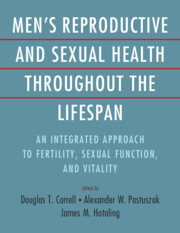 Men's Reproductive and Sexual Health Throughout the Lifespan
Men's Reproductive and Sexual Health Throughout the Lifespan from Section 5 - Medical and Surgical Management of Issues of Male Health
Published online by Cambridge University Press: 06 December 2023
More than one-third of American adults fail to achieve the 7–9 hours of sleep recommended by the American Academy of Sleep Medicine and the Sleep Research Society needed for optimal health and well-being. In addition to primary sleep disorders, such as sleep apnea, insomnia, and restless legs syndrome, many modern societal factors are also thought to contribute to chronic sleep deficiency, such as technology and work-related factors. Interruptions in the natural sleep–wake cycle can be associated with shift work and numerous chronic health conditions. A few studies have investigated the impact of nonstandard shift work on male reproductive health, and a compelling association between sleep and male urogenital health has been demonstrated. This chapter will review the literature on the effect of sleep and shift work on ED, LUTS, hypogonadism, male infertility, and how improved sleep quality can possibly improve common men’s health conditions.
To save this book to your Kindle, first ensure [email protected] is added to your Approved Personal Document E-mail List under your Personal Document Settings on the Manage Your Content and Devices page of your Amazon account. Then enter the ‘name’ part of your Kindle email address below. Find out more about saving to your Kindle.
Note you can select to save to either the @free.kindle.com or @kindle.com variations. ‘@free.kindle.com’ emails are free but can only be saved to your device when it is connected to wi-fi. ‘@kindle.com’ emails can be delivered even when you are not connected to wi-fi, but note that service fees apply.
Find out more about the Kindle Personal Document Service.
To save content items to your account, please confirm that you agree to abide by our usage policies. If this is the first time you use this feature, you will be asked to authorise Cambridge Core to connect with your account. Find out more about saving content to Dropbox.
To save content items to your account, please confirm that you agree to abide by our usage policies. If this is the first time you use this feature, you will be asked to authorise Cambridge Core to connect with your account. Find out more about saving content to Google Drive.